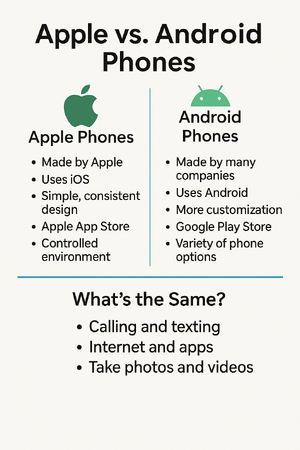Cell Phone Vs Smart Phone

What's the Difference Between a Cell Phone and a Smartphone?

The terms cell phone and smartphone are often used interchangeably, but they aren’t quite the same. Here's a simple breakdown:
Cell Phone (Basic Phone)
A cell phone is a basic mobile phone that allows you to:
- Make and receive phone calls
- Send and receive text messages
- Sometimes take photos or use a simple calendar
These phones are generally easier to use, with physical buttons and fewer features. They’re great for people who want just the essentials.
Smartphone
A smartphone is a more advanced type of cell phone. In addition to calling and texting, it lets you:
- Use the internet
- Download and run apps (like email, weather, social media, or games)
- Take high-quality photos and videos
- Connect to Wi-Fi networks
- Use GPS for maps and directions
- Video chat and check email
- Connect to "Bluetooth" devices like speakers, headphones, and other devices..
Smartphones typically have a large touchscreen, no physical keyboard, and offer far more functions—similar to a small computer.
Summary:
- All smartphones are cell phones, but not all cell phones are smartphones.
- If you're looking for a phone that's simple and focused on calling and texting, a basic cell phone might be best.
- If you want more features like internet access and apps, a smartphone is the way to go.
Apple vs. Android Phones — What’s the Difference?

Think of It Like Different Kitchens
Imagine two kitchens that cook food: both let you make meals, but they use different tools and recipes. Apple and Android are like those kitchens—they do the same things, just in different ways.
Apple Phones (iPhone)
- Made only by Apple
- Use a system called iOS (Apple’s own software).
- Has a simple, consistent design.
- Only runs apps from the Apple App Store.
- Works well with other Apple products (like iPad, Mac, or Apple Watch).
- More controlled environment, which can make it feel more secure and easier to use.
- Apple Account Information
Best for: People who like simplicity and already use other Apple products.
Android Phones
- Made by many companies (like Samsung, Google, Motorola, etc.).
- Use a system called Android (developed by Google).
- Offers more customization—you can change how it looks and works more freely.
- Runs apps from the Google Play Store, plus other app stores too.
- Works with more types of devices, not just one brand.
- More choices in price, size, and features.
Best for: People who like flexibility and a variety of phone options.
What’s the Same?
- Both let you call, text, use the internet, download apps, take photos, and video chat.
- Both have touchscreens and can connect to Wi-Fi and Bluetooth.
- You can use either one to send email, browse websites, watch videos, and more.
Summary:
- iPhones = simpler, consistent, made by Apple only.
- Android phones = more variety, more customization, made by many brands.
What is 5G?
The relationship between 5G and the operation of a cell phone is similar to the relationship between a highway and a car: 5G is the network (highway), and the cell phone is the device (car) that uses it.
5G stands for "Fifth Generation" of mobile network technology.
It is the latest and fastest way for phones and other devices to connect wirelessly to the internet and make calls.
With 5G, you get:
- Faster internet speeds
- More reliable connections
- Less delay when using apps or videos
This means quicker downloads, smoother video calls, and better performance in crowded areas.
Mobile Network Generations Timeline
| Generation | Name | Approximate Start Date | What It Brought |
|---|---|---|---|
| 1G | First Generation | Early 1980s | Analog voice calls only, large car phones |
| 2G | Second Generation | Early 1990s | Digital calls, text messaging (SMS) |
| 3G | Third Generation | Early 2000s | Basic internet access, email, video calling |
| 4G | Fourth Generation | Around 2010 | Fast mobile internet, streaming, apps |
| 5G | Fifth Generation | Around 2020 | Very fast internet, smart devices, low delay |
History
What Is Phone Communication?
Phone communication is the use of a device—called a telephone or phone—to talk to someone who is far away. It allows people to have real-time conversations using electrical signals that travel through wires or radio waves.
Whether it's a landline, a cell phone, or a smartphone, the basic idea is the same:
You speak into a device, your voice is turned into a signal, and that signal is sent to another phone so the other person can hear you.
A Brief History of Phone Communication
1876 – The First Telephone
- Alexander Graham Bell made the first successful voice call using a wire.
- This marked the invention of the landline telephone.
Late 1800s–1900s – Home Phones
- Telephones became common in homes and businesses.
- You needed to be connected by a wire to make a call.
- Early calls often went through a human operator who connected you to the right line.
1960s–1980s – Touch-Tone and Cordless Phones
- Rotary phones were replaced by push-button phones.
- Cordless phones allowed people to walk around the house while talking. These still used a landline but added more convenience.
Car Phones (Before Cell Phones) – 1970s to Early 1990s
- installed directly in a vehicle
- Required a power connection from the car battery
- Used large external antennas for signal
- Operated through radio signals or early analog mobile networks (like the 1G system)
- Typically had a handset connected by a cord
- Very limited mobility — only worked when inside the car
- Often used by business professionals or emergency services
- More expensive to purchase and operate
Cell Phones – Mid-1980s to Present
- Portable and handheld — can be used anywhere
- Run on built-in rechargeable batteries
- Use internal antennas or compact external ones
- Connect to modern cellular networks (from analog 1G to digital 5G today)
- Have wireless communication—no cords
- Offer full mobility, indoors and outdoors
- Used widely by the general public by the late 1990s and 2000s
- More affordable, with many plan options
Summary:
Car phones were widely used from the 1970s through the early 1990s as an early form of mobile communication—though they were limited to use inside vehicles. Cell phones, which began to emerge in the mid-1980s, quickly became more powerful, truly mobile, and affordable by the 1990s, evolving into the smartphones we use today.